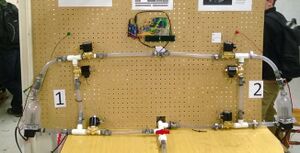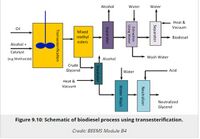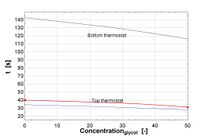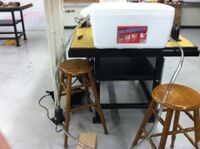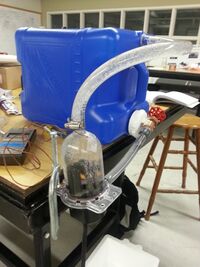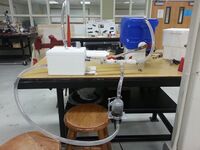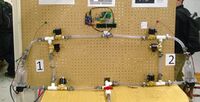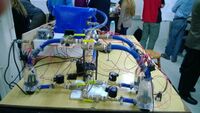Hotstart Thermocycler
The thermo-cycler device will be used for accelerated age testing of heaters used in the heating of diesel engines. It will significantly decrease the cycle time from on to off and allow for analysis of heater performance during testing.
| Prototype showing proposed heater layout | |
| Sponsors | |
| Team Name | Hot Testers |
| Duration | Summer - Fall 2013 |
| Faculty Advisers |
|
| Mentor |
|
Team
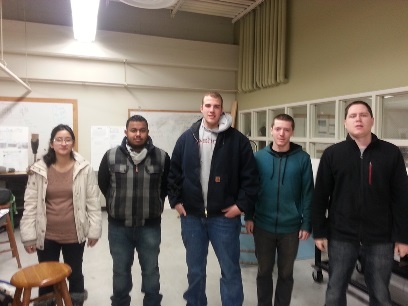
|
Left to right
- Archana Shrestha - Electrical and Computer Engineering
- Ahmed Al Harbi - Electrical Engineering
- Joe White - Mechanical Engineering
- Neal Joslyn - Mechanical Engineering
- Joe Eckroat - Mechanical Engineering
Problem Definition
Background
The R&D lab at Hotstart is charged with testing new product designs for a wide range of markets that use diesel engines. During this testing process, a way to ensure product reliability in a short period of time is needed. Long term testing (1 year +) is not always a feasible option before releasing a product, so a way to speed up this test to the span of a month or two is necessary.
Hotstart manufactures two main types of coolant heaters. The first is a tank heater that uses the heat generated by the heating elements to force the hot coolant out of the top of the system into the engine while the colder coolant coming from the engine takes the place of the heated coolant in the bottom heater creating continuous flow (thermosyphon). The other style is forced circulation, where a pump is used to circulate the coolant across the heating elements and throughout the engine. Both styles use a bimetal snap-action thermostat to control the heating elements keeping the coolant inside the desired temperature range.
Layout Requirements
- Maintain a small footprint to easily fit into test space
- Be easily movable
- Be able to simultaneously test 12 heaters (1kW or lower due to heating requirement)
- Have adjustable flow settings if a heat transfer fluid is utilized
- Allow for multiple voltage sources to power the heaters (1 or 3 phase, 120 – 690V)
- Use components sourced from Hotstart’s current vendors unless absolutely not available
- Contain all foreseeable spills automatically
Control Requirements
- Run on 120V input voltage
- Be capable of safely handling up to 12kW of heating input
- Have adjustable temperature setting for heater input/output
- Display or make available easily, critical data for each test “station” including, but not limited to: cycle count, power failure, heater failure, inlet and outlet temperatures
- Be made from electrical components that are rated for at least 100k cycles at 50°C ambient or mitigate ambient conditions for components that are not properly rated
- Be complete with all documentation along with a manual and troubleshooting guide. If a PLC is used, all documented code must be provided
- Contain all branch circuit protection for all 12 heaters according to UL508A (We may need a supplier to build this part of the panel in order to get the proper sticker inside)
- Be capable of simultaneously running multiple tests with different parameters and set points
Project Learning
Experiment conducted to explore cycle times with smallest volume possible
| |
Math model created to compare cycle times achieved by relocating thermostat
| |
In order to further reduce cycle times of the engine heaters, we built a top-mounted thermostat. Because heat rises, the bottom mounted thermostat was not able to detect temperature changes quickly enough, which left us with huge temperature gradients in the system.
|
Design
Prototypes and testing
"Sandbox" prototype.
| |
This prototype was used to test whether or not a valve could be used to prevent cold water from reaching the heater until it finishes a heating cycle.
| |
*Uses a small “circulation” tank so that proper thermo-siphoning can be achieved
| |
*Utilizes three solenoid valves per heater to trap liquid while heating (small volume=fast cycles)
| |
*Eliminates two of the three solenoid valves at each heater station, saving a lot of money
|
Physical Layout

|
Rendering showing the final physical layout of the system
- Stacked cell design saves space by putting one cell on top of the other
- Steel table construction can be created with castors
- Each heater station allows for mounting of 1kW heaters as well as enough room for larger tank heaters
- Wall outlining table surfaces automatically containing spills
System Diagram
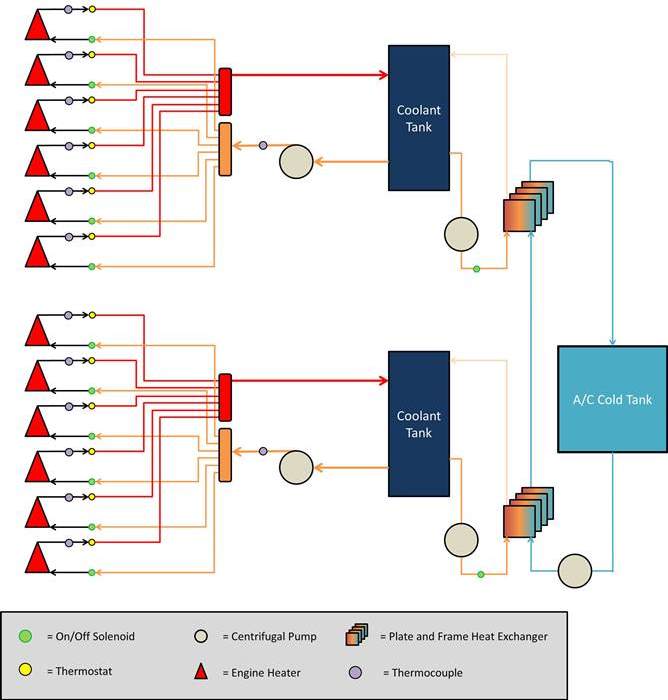
|
This design uses two cells that can operate at independent temperatures. Each cell can be used to test six 1kW heaters at once.
Design features
- Cold reservoir: A refrigeration unit keeps a 10 gallon tank of coolant at a constant temperature of 40 degrees F
- Heater reservoir: Each cell contains a heater reservoir which is used to supply coolant to each heater in that cell at a desired temperature (colder than 100F)
- Heat exchangers: A plate & frame heat exchanger is used to exchange heat between the heater tank and cold tank for each cell
- The cold side is supplied by the cold reservoir and is pumped in series through both heat exchangers. Because of this design feature, the coldest temperature set point should be chosen closest to the cold reservoir.
- The hot side is supplied by a pump connected to the heater reservoir. The pumps will only be used to keep the coolant in the heater reservoir within the limits of the specified temperature, for example 70F +-2F. In order to achieve this, a solenoid valve will control flow through the hot side of the heat exchanger.
- Heating cycle: Each heater will heat a small volume of coolant in a closed loop until the coolant reaches 120F. At this point, solenoid valves will open the loop and allow coolant from the reservoir to flush the loop, and the cycle starts over.
- Pressurized rails: Each cell uses a pump to pressurize a manifold of fluid which is used to flush a heater at the end of its cycle.
- Valve control: Each valve in the system will be controlled by a master controller. The valves in the heating cycle loops will open or close depending on the status of the heater (on/off).
- Thermostat override mode: Each heater will be able to operate based on user input heating temperatures rather than the automatic temperatures built into the thermostats
- Test information: A master display will show the following information about all of the heaters
- Cycle counter
- Average time/cycle
- Predicted completion time to desired cycle count
- Heater Status (on/off)
- Inlet/outlet temperatures of heaters as well as reservoir temperature
- Emergency/error alarm with built-in cycle shutdown
- Cycle counter
